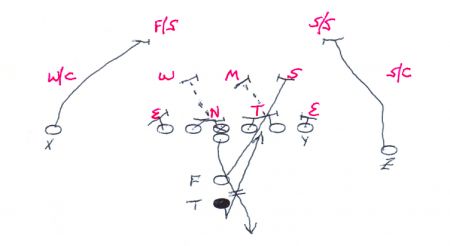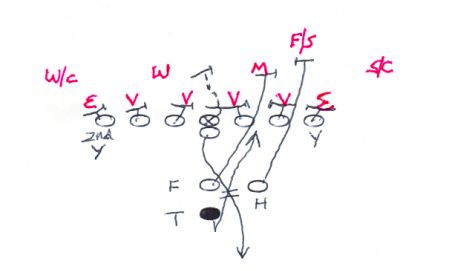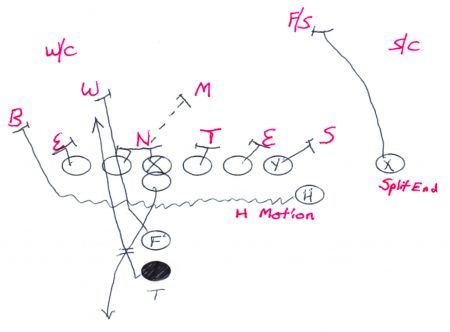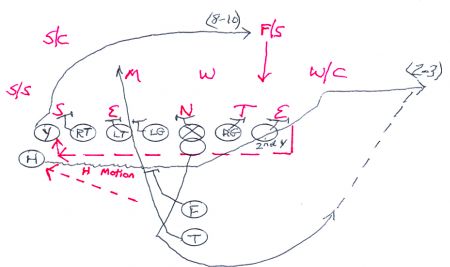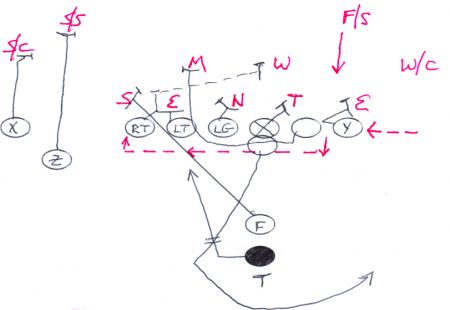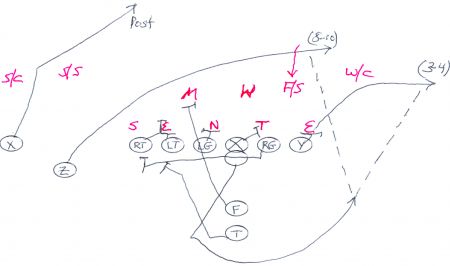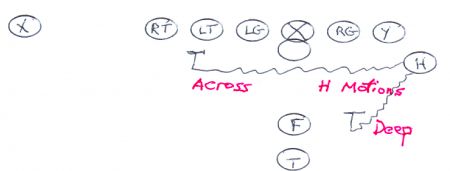Article CategoriesAFM Magazine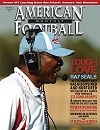
|
The Power Run Game and the Spread Offense – Can They Co-Exist?by: Dale L. Sprague© More from this issue Since the popularization of the numerous forms of the spread offense in the late 1990’s and now into the new millennium, many coaches have seen a drastic change in the way they attack today’s defensive structures and coverage shells. As a coach who has always favored the power and lead-back run plays and series, I am constantly researching methods of running the Isolation Play (See Diagram 1), the Blast Play (Diagram 2) and the Power Off-Tackle Play with a gap down, pull, kick-out blocking scheme (Diagram 3).
Diagram 1. Isolation Play
Diagram 2. Power I – Blast Play
Diagram 3. Power Off-Tackle Play As a small college head coach and offensive coordinator for over 22 years, I was fortunate to have coached some very talented tailback/halfback players who rushed for over 1,000 yards in several seasons. One, at the NCAA Division III level, accumulated 5,281 yards during his four-year career. Needless to say, I have always favored an I formation and power running attack to get the football into the hands of these athletes. Most recently in my coaching career, I have served as a defensive coach and defensive coordinator and have seen the difficulty in defending today’s spread offenses and their wide-open passing and multiple zone-read rushing attacks. Still, even today, the most difficult plays to defend week after week are the power rushing attacks. This includes a hard-nosed downhill running tailback hitting the line of scrimmage behind a lead back blocking a linebacker and a well-coached offensive line in man-to-man blocking schemes. This helps to control multiple front defenses and various blitzes. I am stubborn as a football coach, but I also know that research and innovation are very important in any sport. Each year, I like to see how these offenses and defenses as well as the specialty units of teams have ‘tweaked’ their methodology and brought it to a different level. This past off-season’s research and DVD sessions revealed to me some new and unique styles of running the power run game plays. This included formational adjustments, various shifting and Tight End/H-Back trading, and blocking schemes that now allow the power game to counter many defensive overloads of eight (Diagram 4) and nine man (Diagram 5) in the box which we are seeing more of in today’s game.
Diagram 4. Eight Man Box with SS ‘Down’
Diagram 5. Nine Man Box with Safeties Supporting the Front Like many coaches, I am a borrower and copier, meaning simply that I take things from those I have researched and put them to our own usage. Much of what I was able to research came from watching DVDs of the Green Bay Packers, Stanford University, Oklahoma and Oklahoma State University, and attending spring drills at colleges such as Virginia Tech, Virginia, and Marshall. We all benefit from studying each other. This is one of the things about football and football coaching which make it special. Many offenses are now lining up in spread sets, such as ‘Bunch’ and ‘Bunch Tight’ formations, with the use of an H-Back as one of the inside aligned receivers, and then shifting back into I formation sets and unbalanced I sets (See Diagrams 6, 7, and 8).
Diagram 6. Gun Tight Bunch Set with Shift to Pro I Set
Diagram 7. Pro Wing Trips Set – Shift to Double Pro I Set
Diagram 8. Tight Bunch Set – Shift to Unbalanced Wing I Set The H-Back is a hybrid positional player, half tight end and half fullback, and he can be utilized as a lead blocker, motioning lead blocker, receiver and pass protector. This player can also be utilized as a second tight end through the use of shifting and/or lining him up in the Bunch formation or even in the backfield and shifting him up to the line of scrimmage (See Diagrams 9 and 10).
Diagram 9. I Unbalanced with a 5-Man Surface – Shift Twins I
Diagram 10. Gun Empty Set - Shift to Unbalanced I Once the offense shifts to these sets, the power run game options are many. Also, through the use of H-Back motion, the offense can attack along a diverse front, either with the run or with the play action pass (See Diagrams 11 and 12).
Diagram 11. I Unbalanced with a 5-Man Surface – Shift Twins I
Diagram 12. Gun Empty Set – Shift to Unbalanced I – H Motion – Isolation Play to the Weak Side with H Kick Out This sets up the series aspect of the power run game, as it allows the use of a base run play, a counter (See Diagram 13), and a play-action pass which comes off the base run action (See Diagram 14). The ability to shift from a one-back look to a two-back set of an unbalanced two-back set gives the defense the conflict of having to reset or realign their front, their linebackers, and their coverage shell to adjust to these formational changes. Diagram 15 shows a shift to an unbalanced set, combined with H-Back motion back to the weak side followed by a run to that weak side surface. This can be effectively used vs. defenses which reset their front to the unbalanced set, but leaves itself vulnerable away from the formation strength.
Diagram 13. Shift to Bunch Tight – Counter Trey Weak with H-Back as Lead Blocker
Diagram 14. Shift to ‘Long’ Formation with H-Wing – Isolation Boot Pass Back to Weak Side
Diagram 15. Shift to ‘Long’ Formation With H Wing – H Motion Weak Side – Isolation ‘Blast’ Play Weak Side Additionally, the unbalanced set can be used without losing an eligible receiver. Here, the offense leaves the tight end to the weak side while bringing an offensive tackle over to the strong side of the formation. This gives the offense the ability to run the power game to the three-man surface with two offensive tackles at the point of attack (See Diagram 16). This also adds the threat of a potential short side bootleg pass off the power run game action back to the short side (See Diagram 17).
Diagram 16. Shift to ‘Tackles Over’ Formation – Power Off-Tackle Strong Side (Red lines = Shifts)
Diagram 17. Shift to ‘Tackles over’ Formation – Power Boot Pass Weak Side This gives the offense a complete ‘series’ of packaged plays to attack various schemes and coverages, as well as controlling the secondary force and outside linebacker play in the defensive perimeter. These unbalanced sets can also be complemented with the use of an H-Back wing who can be aligned to the weak side and can motion either across the formation or back into a backfield set to be used as a protector or lead blocker (See Diagram 18).
Diagram 18. ‘Tackles Over’ Formation with H Back Set as a Wing to the Weak Side with the Tight End – H Motions Football is always changing and evolving as coaches find new methods of attacking, defending, and expanding upon ideas that may already be in place. For those of us who love the power run game and its multiple-play series and combinations, these innovations have enabled us to complement the many run and play-action series that we have utilized through the years simply by using shifting, motioning, personnel usage, and new formations, making it more difficult to defend. The spread offense is here to stay, but so is the power run game, with a little ingenuity. |
|
| HOME |
MAGAZINE |
SUBSCRIBE | ONLINE COLUMNISTS | COACHING VIDEOS |
Copyright 2025, AmericanFootballMonthly.com
All Rights Reserved


